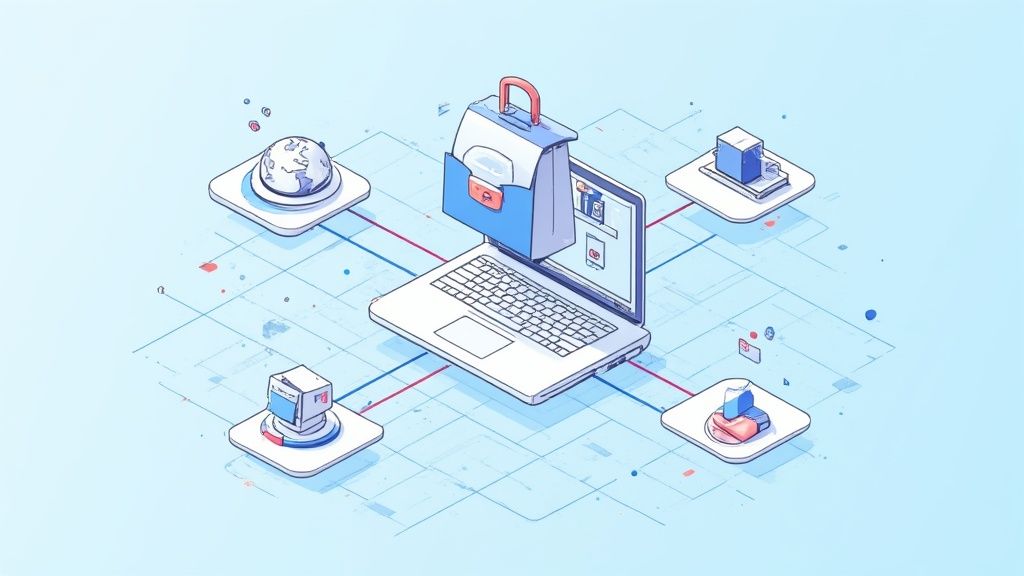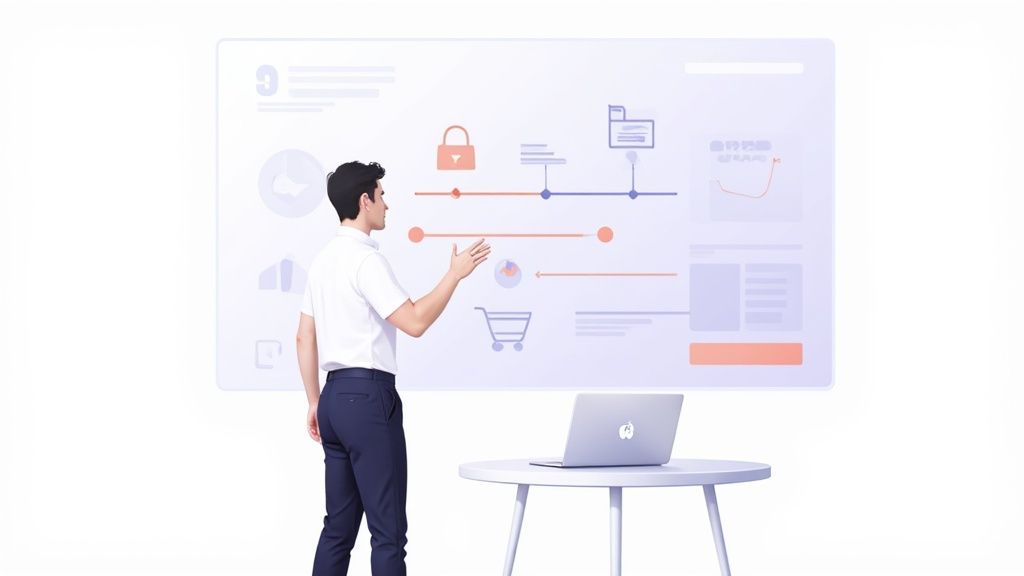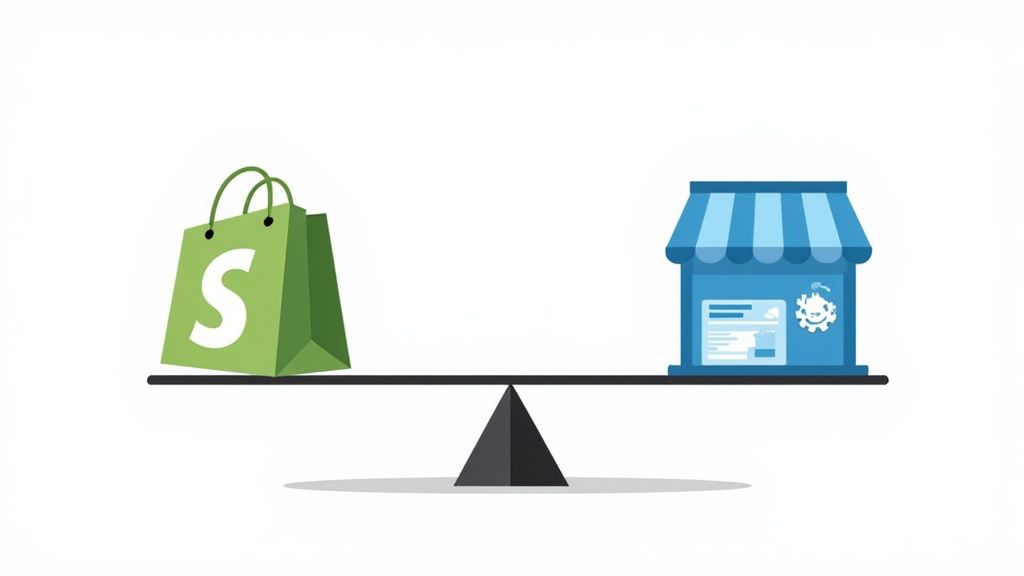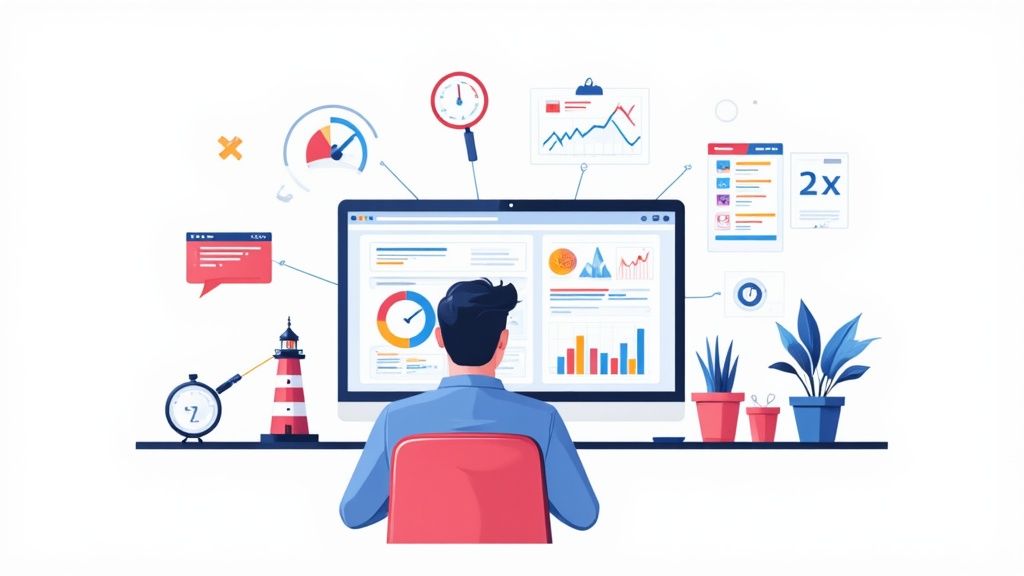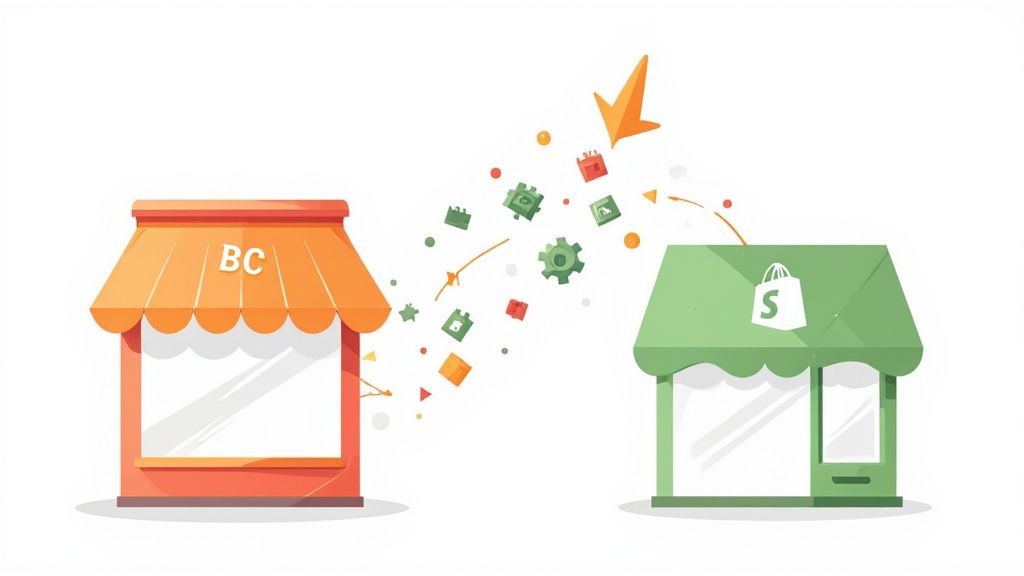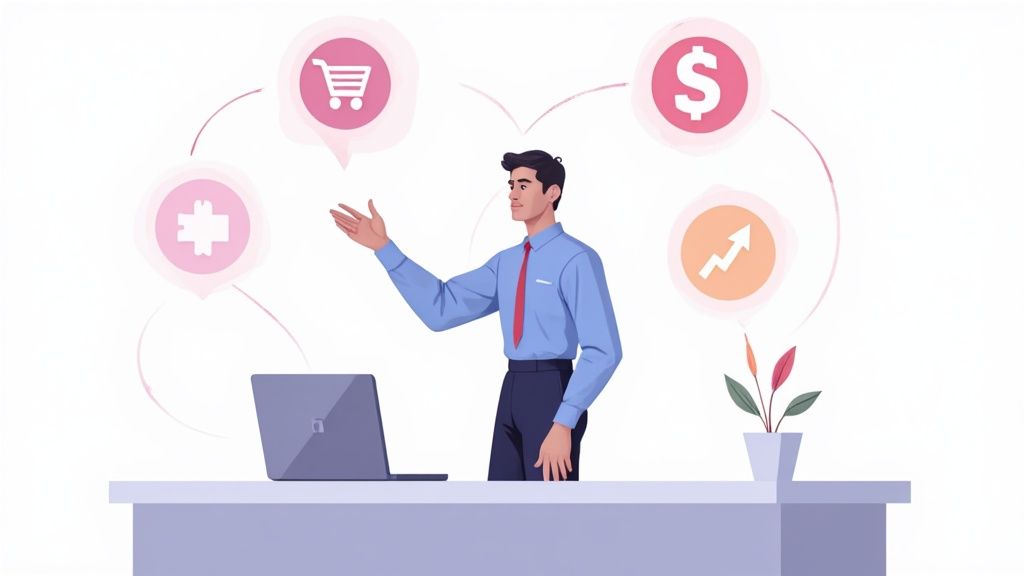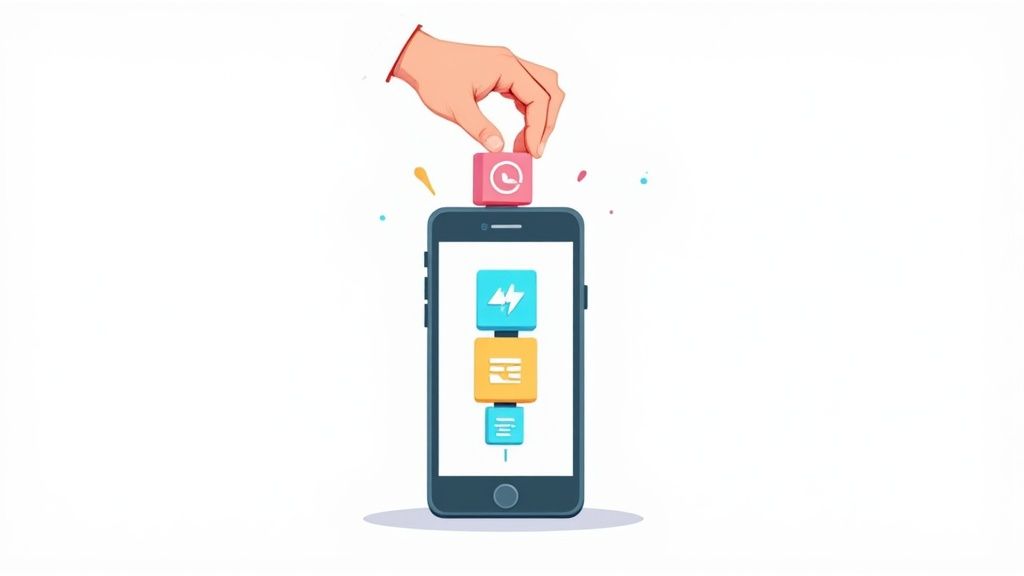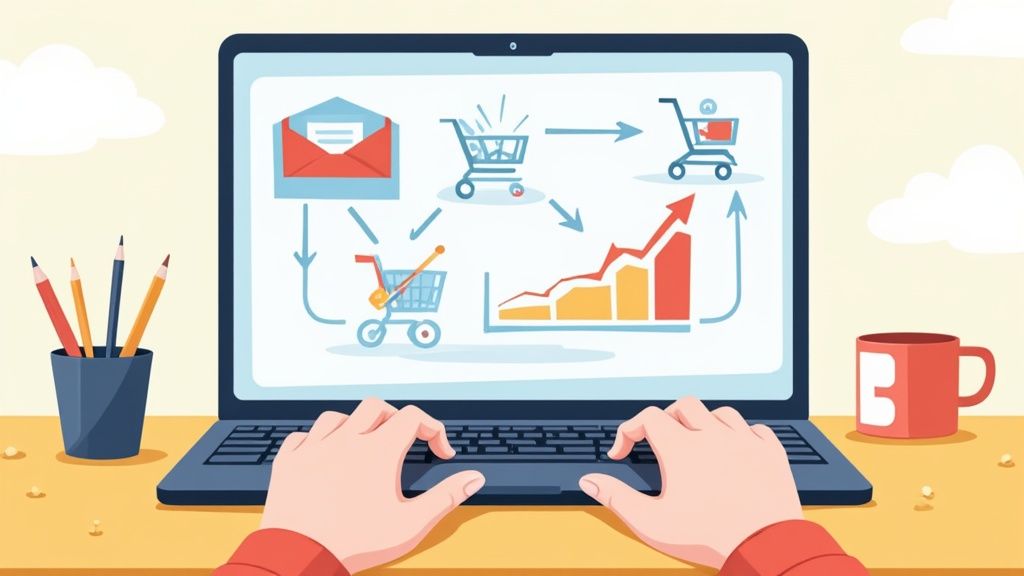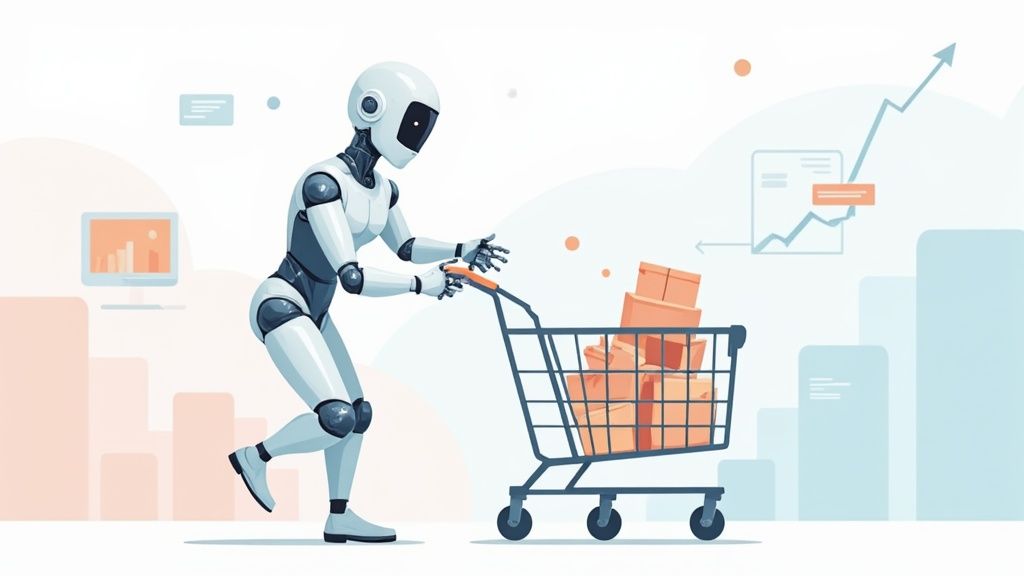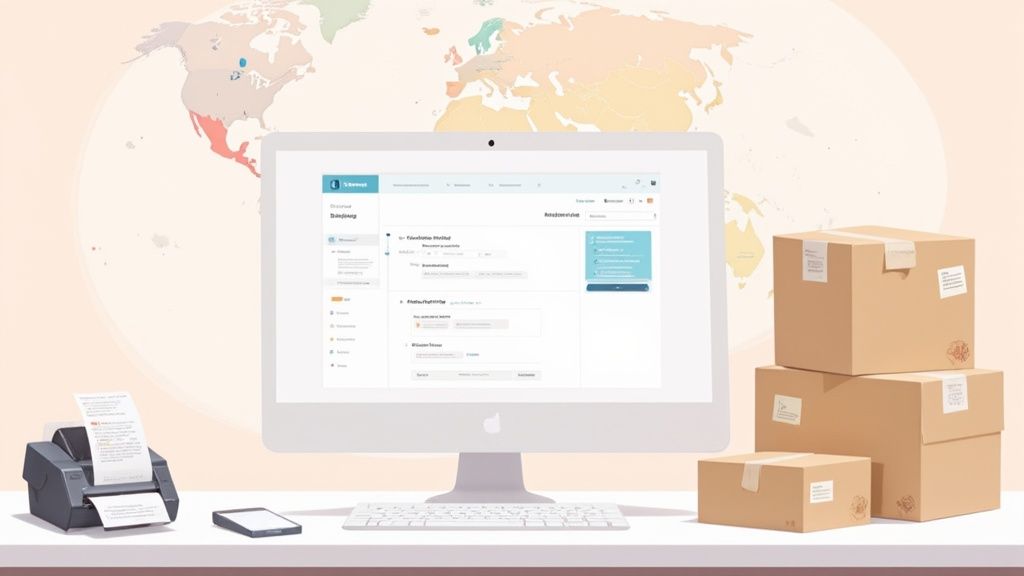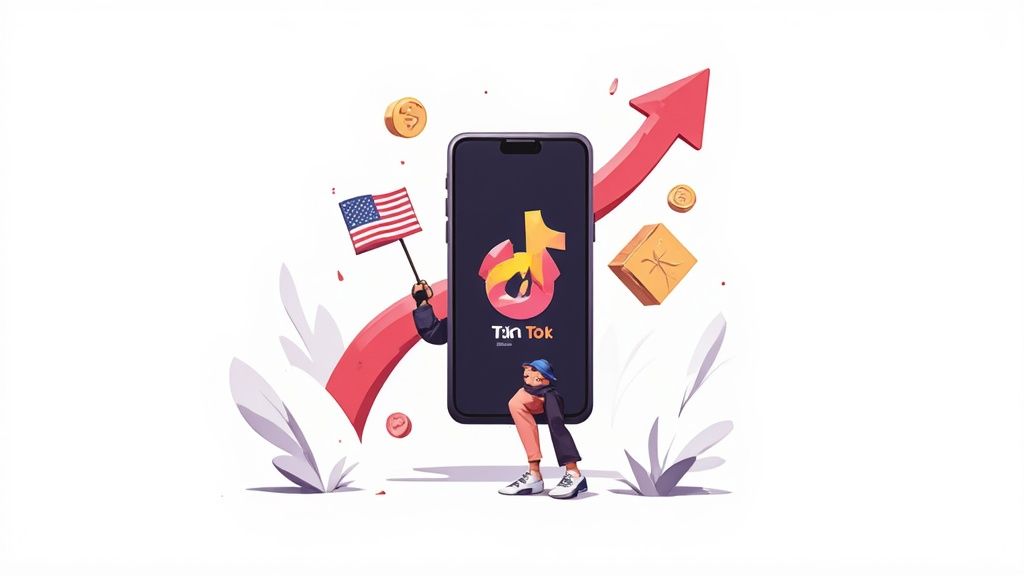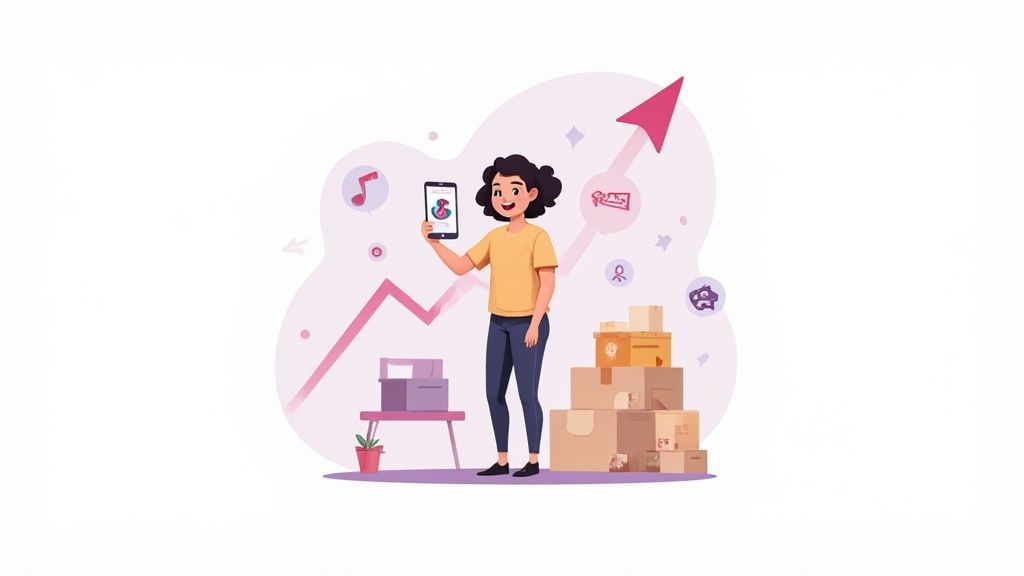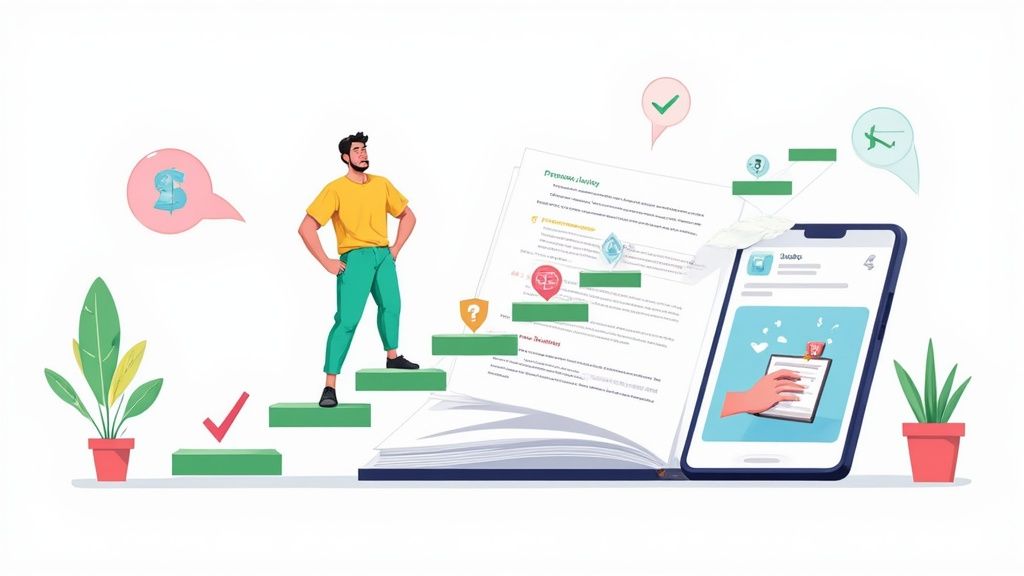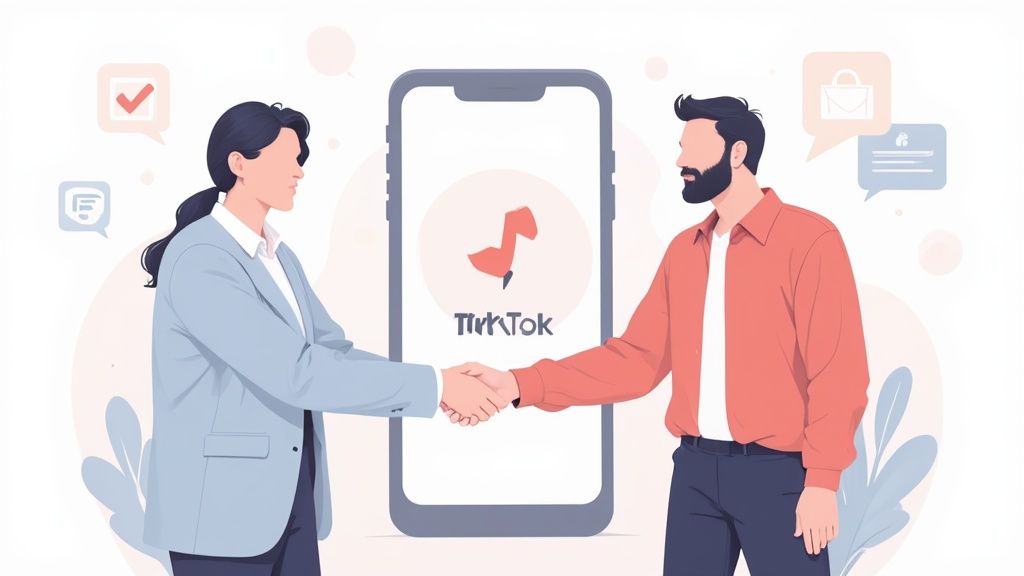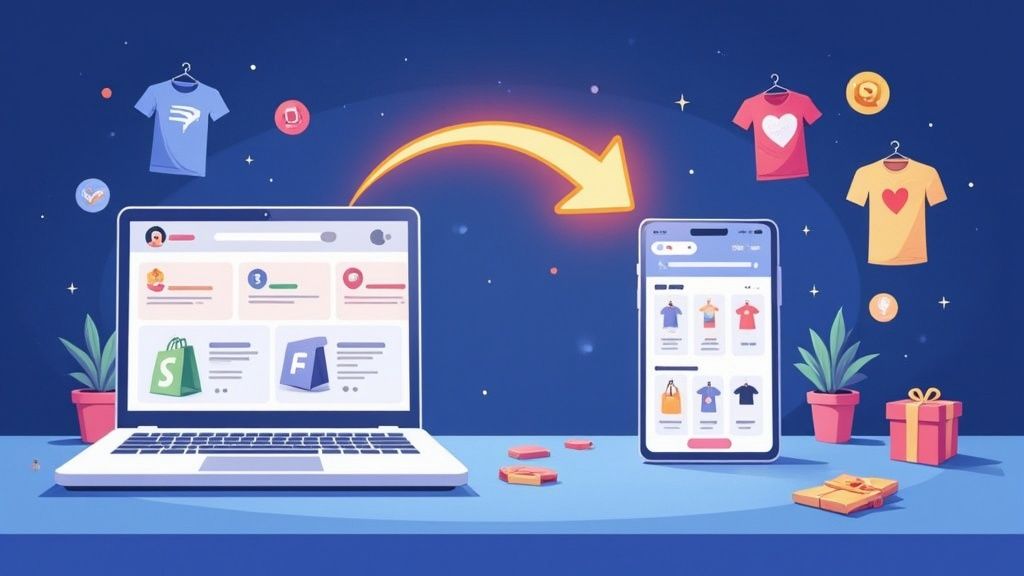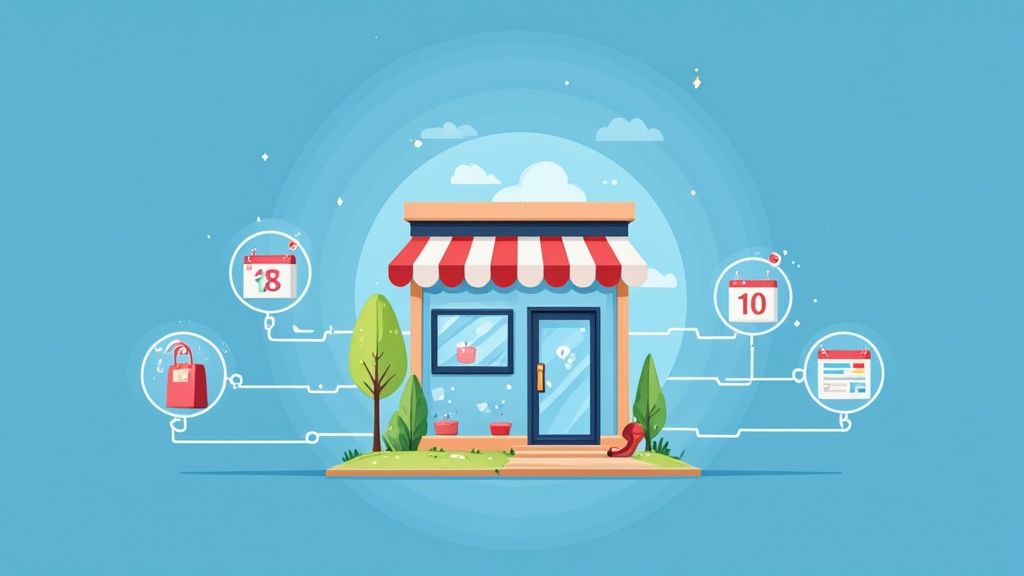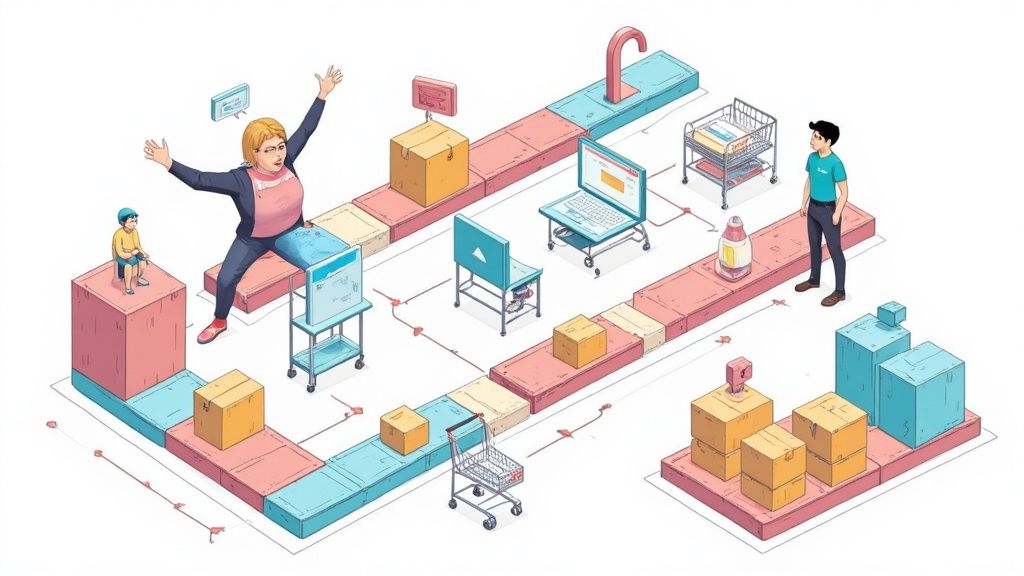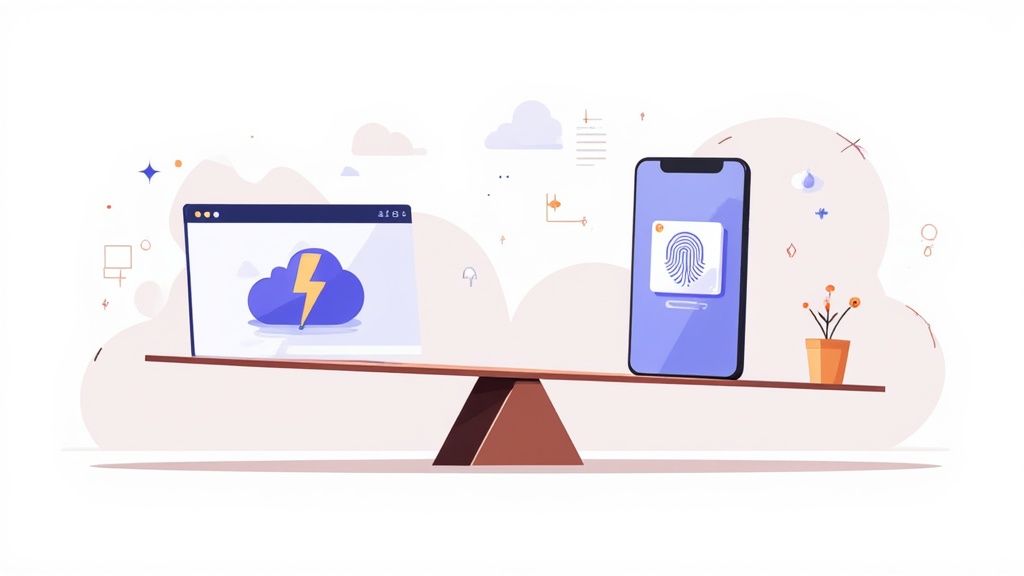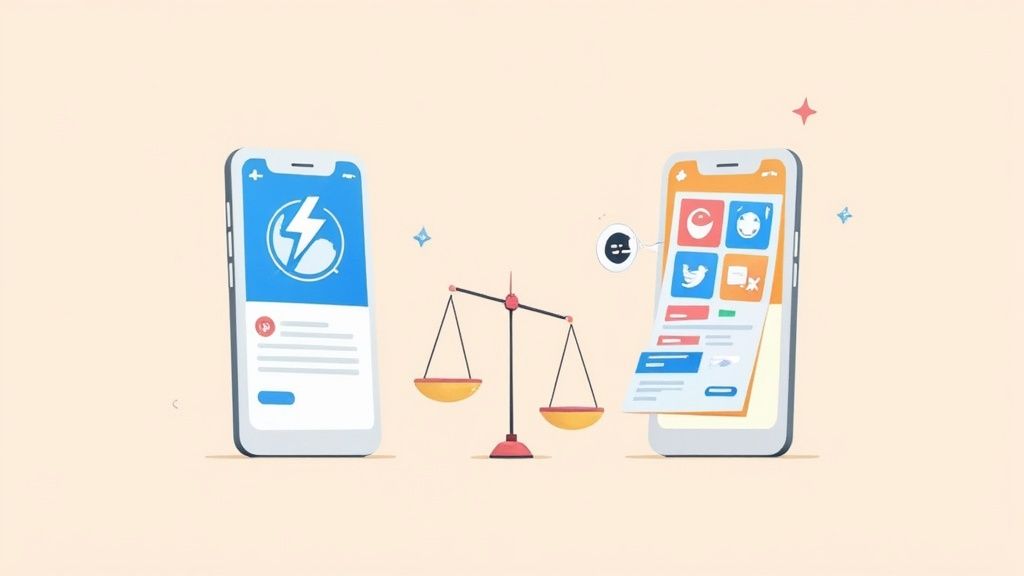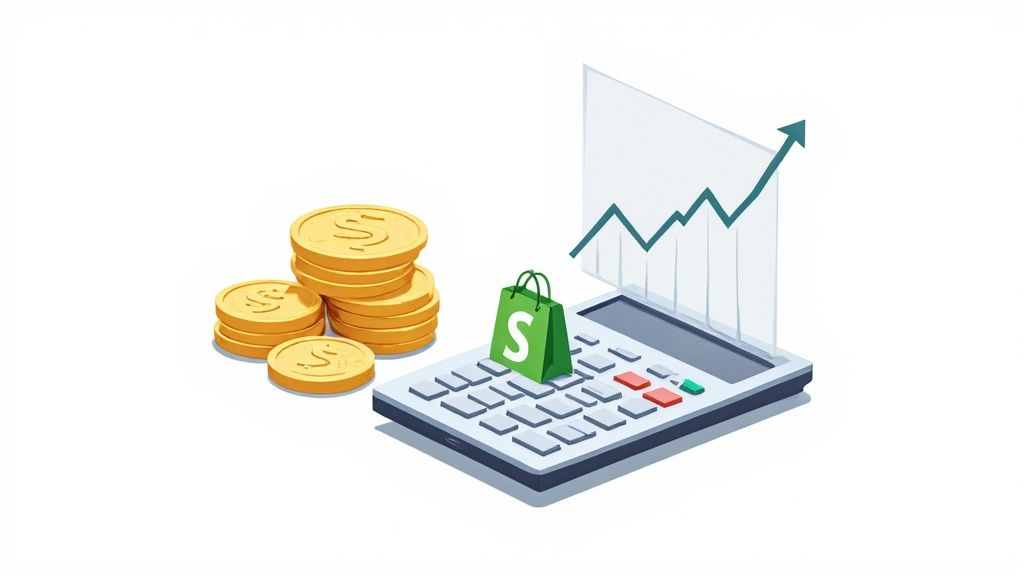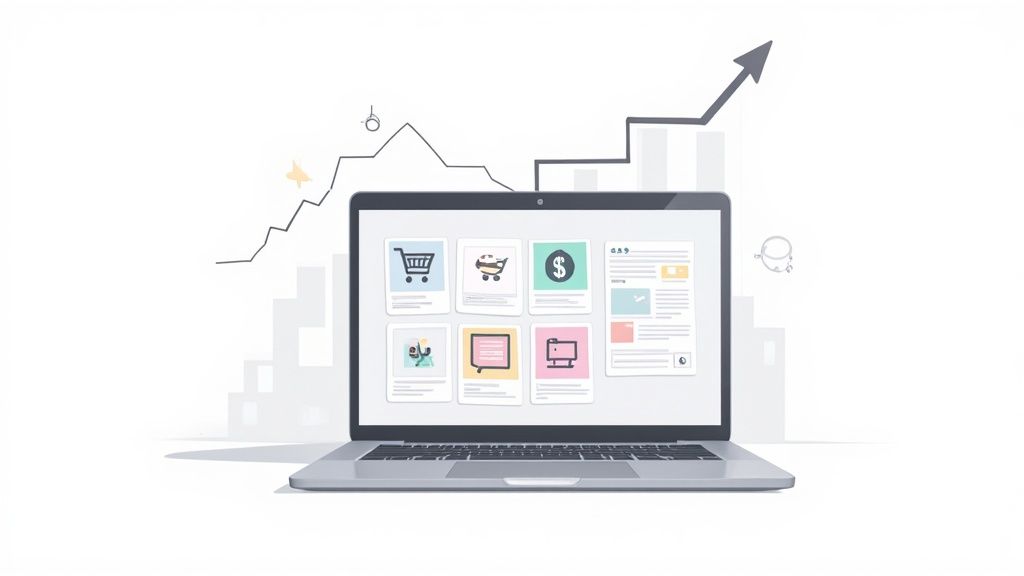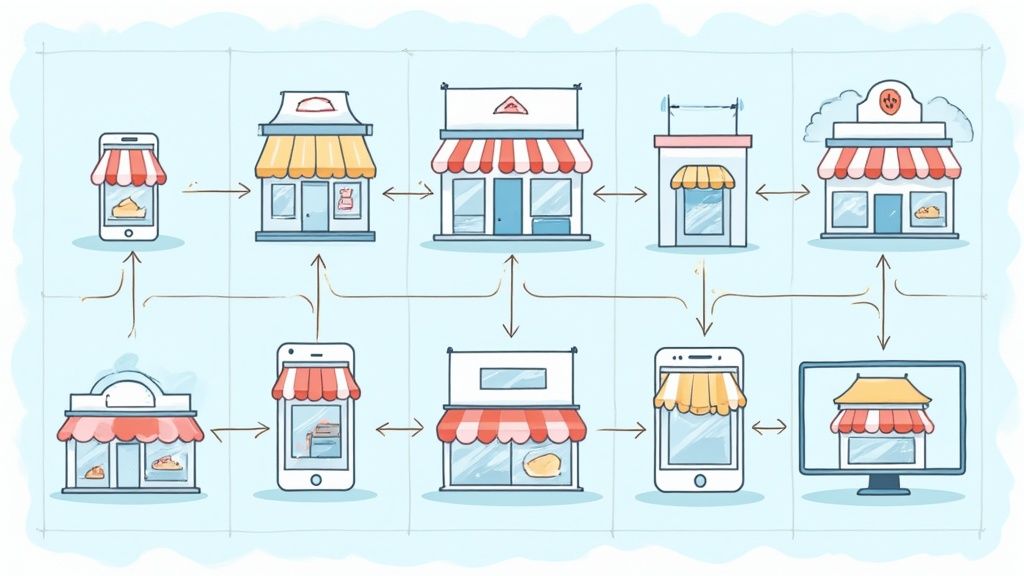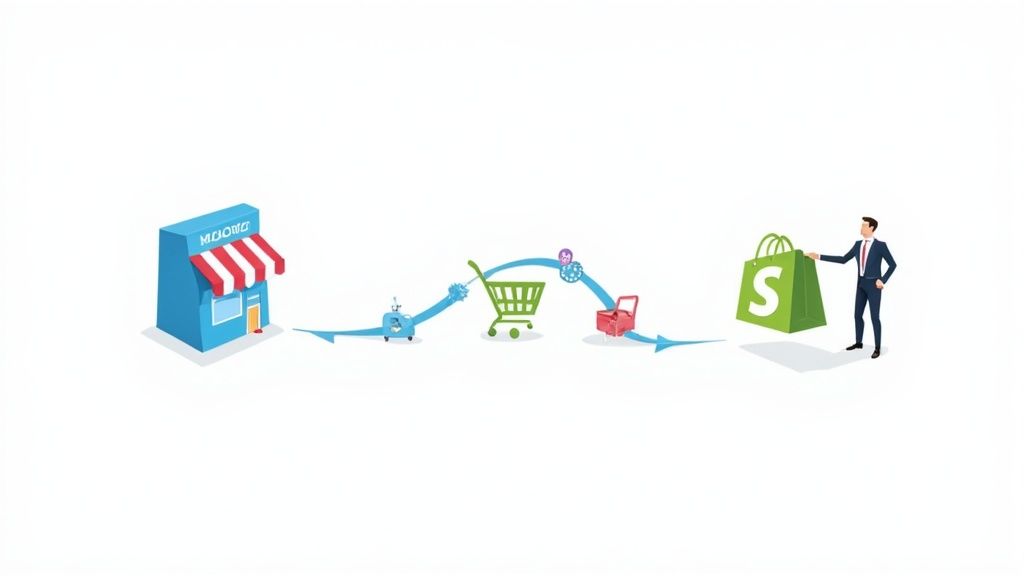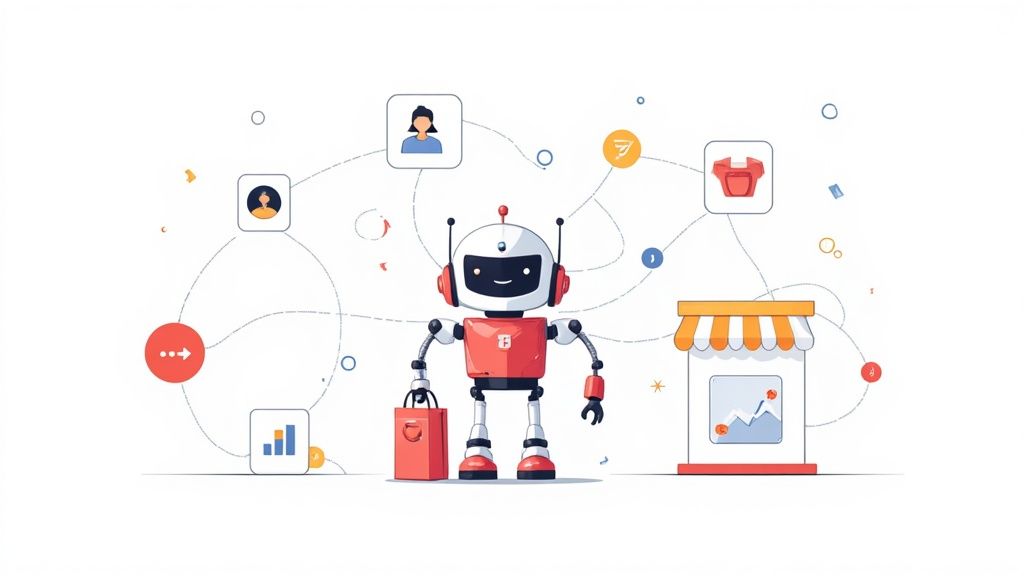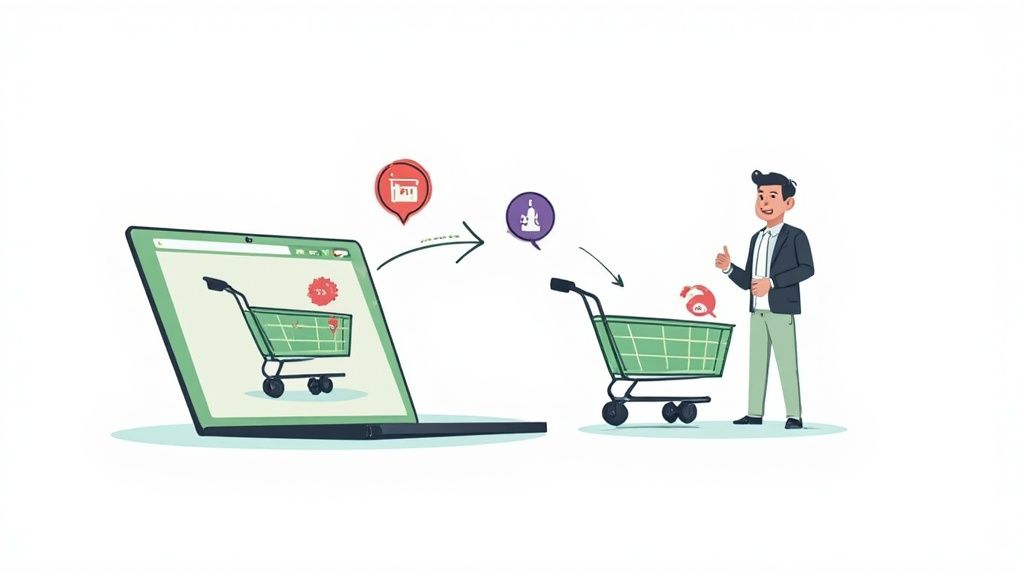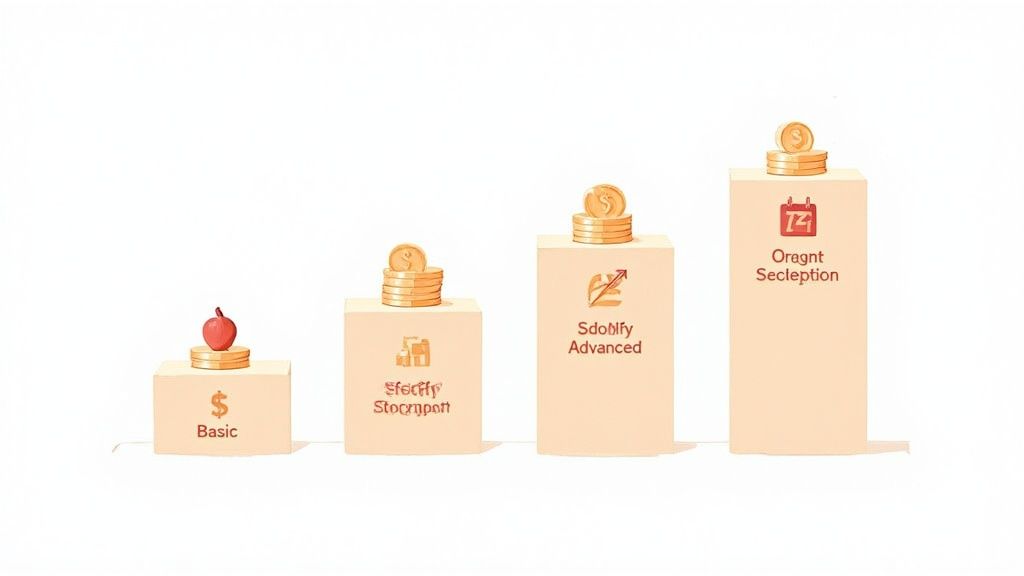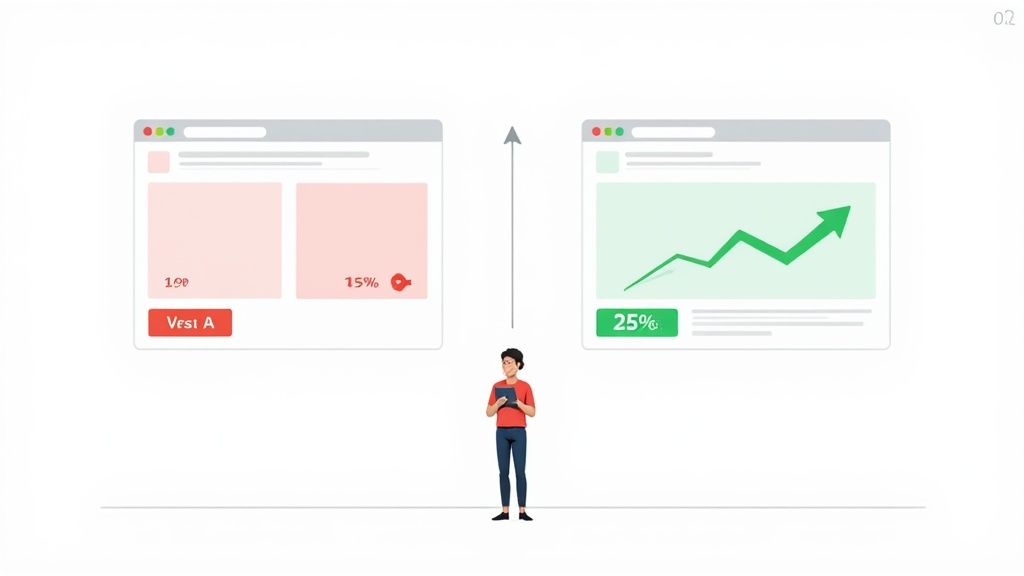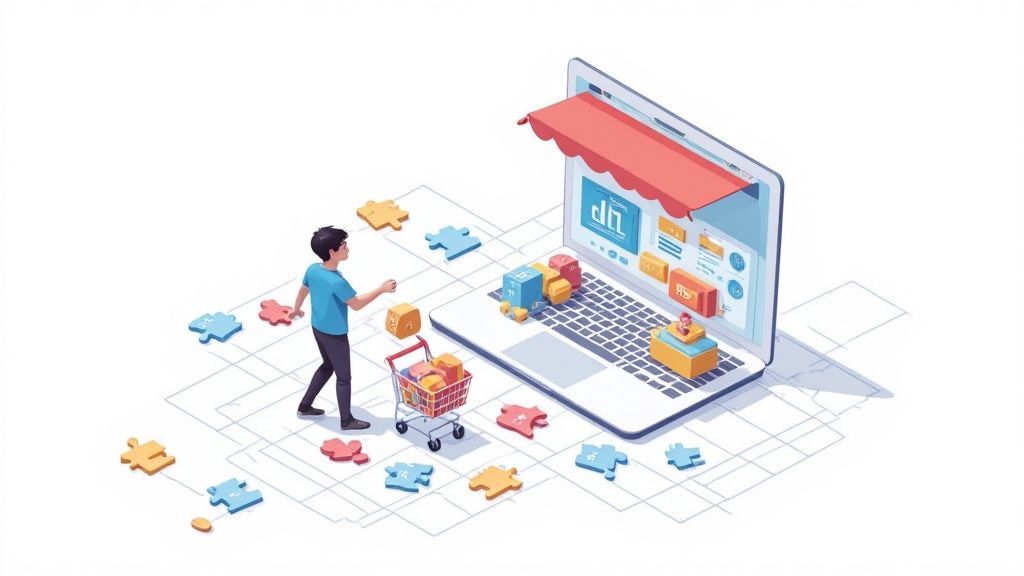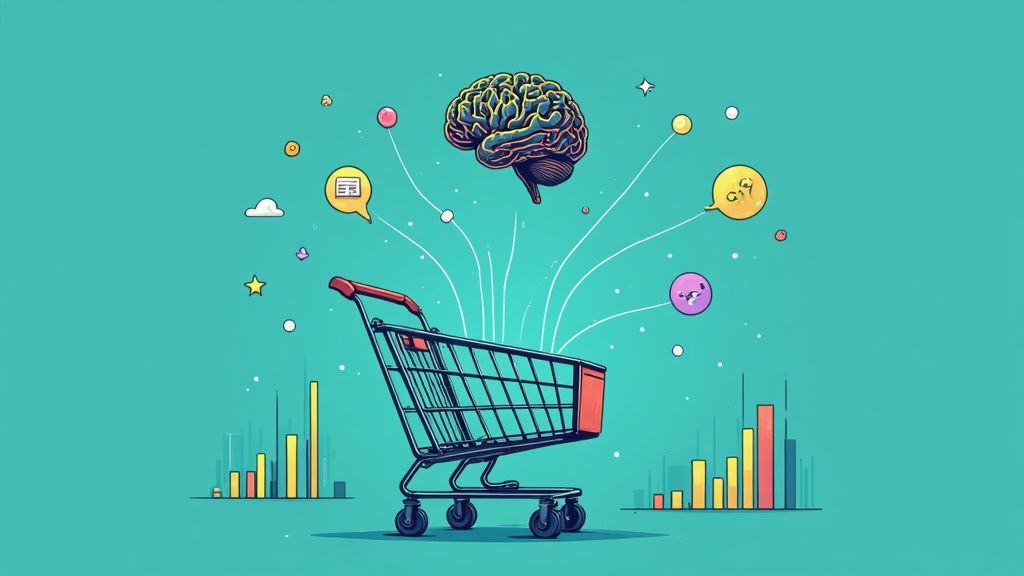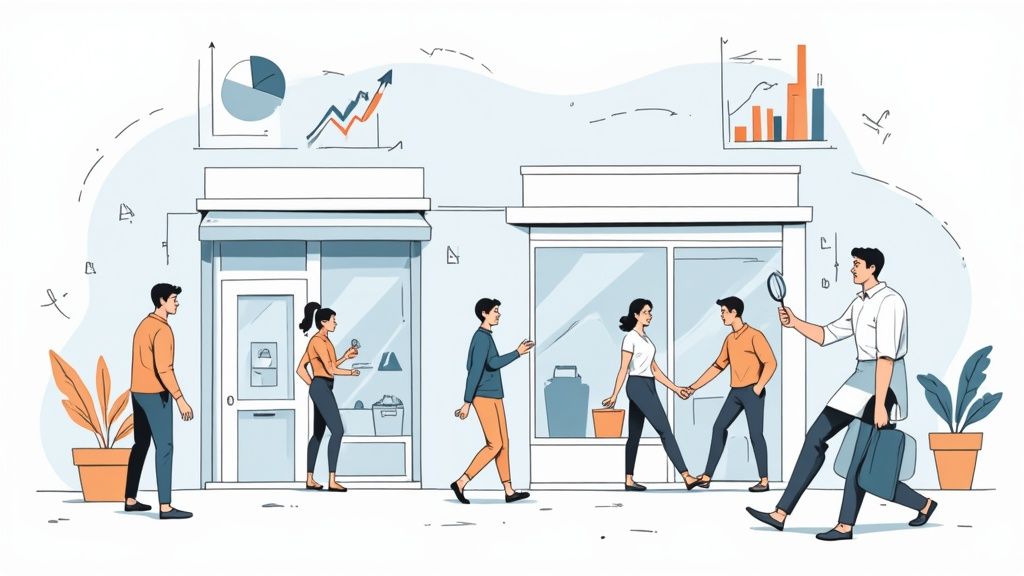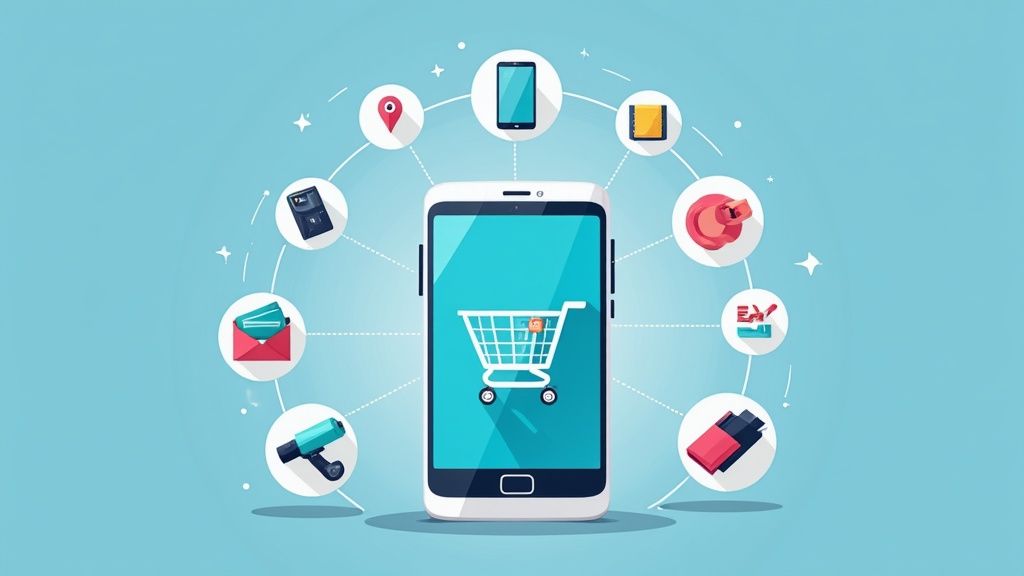
Mobile commerce, or m-commerce as it's often called, is simply the buying and selling of stuff through wireless devices like smartphones and tablets. The easiest way to think about it is having an entire shopping mall that fits neatly in your pocket, open for business 24/7. It’s the natural next step from traditional e-commerce, built for how we live today—always on the move.
Understanding Mobile Commerce Fundamentals

But m-commerce isn't just a shrunken-down version of a desktop website. It’s a whole ecosystem designed from the ground up for the unique features of mobile devices. It signals a major shift in how people shop, moving away from sitting at a desk to a more fluid, accessible, and instant retail experience.
This whole movement is powered by one simple fact: we almost always have our phones with us. That constant connection gives businesses a direct line to their customers at any time of day, whether they're on their morning commute, waiting for a coffee, or just chilling on the sofa at home.
The Core Channels of M-Commerce
To really get what mobile commerce is, you have to look at the different ways it actually reaches customers. M-commerce typically works through a few main channels, each offering its own kind of user experience.
- Responsive Mobile Websites: These are your standard websites, but they're smart enough to automatically resize and rearrange content to look good on any screen. This gives everyone a solid, user-friendly experience on their phone or tablet without needing to download anything extra.
- Dedicated Shopping Apps: Native apps deliver a much richer and often faster experience than a mobile site. They can tap into a phone's built-in features, like the camera for virtual try-ons or GPS for location-based deals, and send push notifications to keep customers in the loop.
- In-App Purchasing: This is all about buying things directly inside an app that isn't just for shopping. Think about subscribing to a streaming service, buying extra lives in a mobile game, or unlocking premium features in a productivity app.
M-commerce is not just about transactions; it's about creating a seamless and context-aware journey that meets customers wherever they are. From browsing on social media to making a one-tap payment, the entire experience is optimized for convenience.
At the end of the day, all these channels work together to make shopping ridiculously easy. By understanding these pieces, businesses can build a solid mobile strategy that empowers customers to buy whatever they want, whenever they want, from anywhere.
The Journey from E-Commerce to M-Commerce
The move from desktop shopping to buying on our phones didn't happen overnight. It was a slow burn, fueled by new tech and a massive shift in how we live our lives. Think back to the early days of online shopping—you were literally chained to a desk, listening to the screech of a dial-up modem. E-commerce was a specific destination you had to sit down and travel to.
Then, the internet started to cut the cord. The first stabs at mobile browsing were painful, to say the least. We were trying to navigate clunky websites on tiny flip phone screens with terrible keypads. Sure, it was technically possible to shop, but it was more of a bizarre experiment than a practical way to buy anything. The experience was frustrating, and the technology just wasn't there yet.
The Smartphone Revolution
The real game-changer landed in 2007 with the first iPhone. Suddenly, millions of people had a powerful, easy-to-use computer right in their pockets. This wasn't just about making the internet mobile; it made it accessible, intuitive, and visually stunning.
This incredible new hardware set the stage for the software that would truly define m-commerce: the app store. Developers could finally build dedicated shopping apps, creating experiences that were light-years ahead of any mobile website at the time. This was the moment mobile commerce as we know it was truly born.
This timeline really puts into perspective the key milestones that sent m-commerce into overdrive.

As you can see, every leap in technology, from better phones to slicker payment systems, directly pumped up mobile commerce revenue.
Removing Friction from Mobile Payments
The last major hurdle was the checkout. Nobody enjoyed painstakingly typing in credit card numbers and shipping details on a tiny touchscreen. It was a huge pain point that caused countless abandoned carts. But then, technologies like digital wallets and one-tap payments came along and smoothed everything over.
Advancements like Apple Pay and Google Pay transformed mobile payments from a cumbersome task into a seamless, secure action. This convenience was the final push that made consumers comfortable completing entire purchases on their phones.
The growth since then has been absolutely staggering. The "mobile-first" approach is no longer a suggestion; it's the reality of retail. In 2023, mobile e-commerce revenue hit an incredible $2.2 trillion, which accounted for 60% of all e-commerce sales worldwide. This trend isn't slowing down, which is precisely why understanding what is mobile commerce is non-negotiable for any business today. You can dive deeper into the key mobile marketing statistics that prove just how big this shift has become.
The Pillars of a Strong Mobile Commerce Strategy
Building a successful mobile presence is a lot like constructing a sturdy building; you need several strong pillars working together to support the whole thing. It's no longer enough to just have a mobile-friendly website and call it a day. A winning mobile commerce strategy is a thoughtful blend of the right technology, a fantastic user experience, and smart marketing.
Each piece of the puzzle plays a specific role, from the very first moment you attract a visitor to making their shopping journey completely effortless. When these pillars are solid, they create a seamless experience that doesn't just drive sales—it builds the kind of customer loyalty that lasts.
Let's break down the essential elements that form this foundation.
Responsive Design and Mobile-First Thinking
The absolute bedrock of any m-commerce strategy is responsive design. This simply means your website automatically adjusts its layout, images, and text to fit perfectly on any screen, whether it’s a small smartphone or a large tablet. It ensures every user gets a flawless, easy-to-navigate experience without any of that frustrating pinching and zooming.
But "mobile-first" thinking takes this a step further. It's a design philosophy where you actually plan the entire user experience for the smallest screen first and then scale it up for bigger devices. This forces you to prioritize what's truly important, leading to a cleaner, faster, and more focused experience for the majority of your users, who are probably on their phones.
Dedicated Mobile Apps for Loyalty
While a responsive site is critical for getting discovered, a dedicated mobile app is your powerhouse for keeping customers coming back. Apps just offer a faster, more personal, and more convenient experience. They can safely store user information, enable one-tap checkouts, and generally run much quicker than a mobile browser.
For businesses looking to forge a richer, more direct channel with their customers, exploring options for building a mobile app for your e-commerce store is the logical next step in a robust m-commerce strategy.
Frictionless Mobile Payments
A clunky, complicated checkout process is the number one reason people abandon their carts on mobile. Let's face it, typing in credit card details and shipping addresses on a tiny screen is a pain. This is where frictionless mobile payments become completely non-negotiable.
Here’s a quick look at how a typical m-commerce transaction flows, and you can see just how critical the payment step is.
Integrating digital wallets like Apple Pay, Google Pay, and PayPal is a game-changer. These options let customers complete a purchase with a single tap or a quick biometric scan, drastically reducing the effort needed and, in turn, sending your conversion rates up. If you're curious about the technical side, this detailed payment gateway integration guide is a great resource.
The goal is to make buying something on a phone easier than putting it back on the shelf. The fewer steps and fields a customer has to complete, the more likely they are to follow through with their purchase.
By zeroing in on these core pillars—responsive design, dedicated apps, and seamless payments—you create a mobile commerce ecosystem that isn't just functional but genuinely enjoyable for your customers.
How Mobile Commerce Benefits Your Business
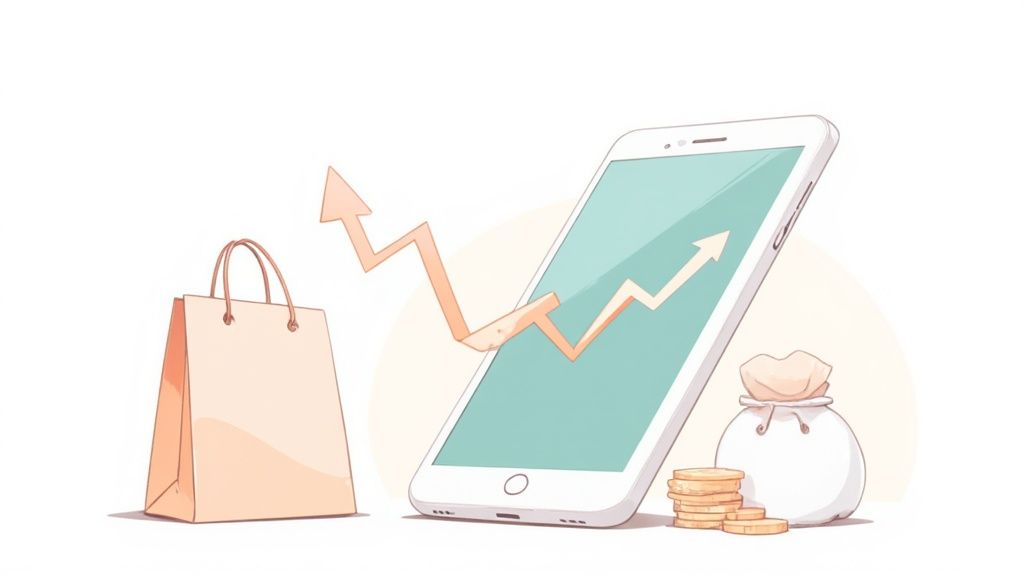
Going all-in on mobile isn't just about adding another sales channel. It's about fundamentally changing how you connect with customers, weaving your brand directly into their daily lives. The payoff is real, showing up in both your revenue numbers and your customer loyalty.
The most obvious win is sheer convenience. Mobile lets people shop the second inspiration strikes—whether they're on the train, taking a lunch break, or lounging on the couch. This "always-on" access breaks down the barrier of needing to be at a computer, capturing impulse buys and sales that you would have otherwise missed.
Ultimately, that convenience adds up to a much better customer experience. A clean, easy-to-use mobile store makes people feel understood. And when buying is that simple, they're far more likely to come back for more.
Expand Your Reach and Your Revenue
Think about it: mobile commerce literally puts your store into the hands of a global audience. With a smartphone, geographical lines blur, opening up entirely new markets and revenue streams that once felt out of reach. You're no longer just selling to people who can find a physical store or make time for a desktop.
And the data backs this up in a big way. By 2025, m-commerce is expected to make up 59% of all global retail eCommerce sales. That's a staggering $4.01 trillion. This isn't a small shift; it means a huge chunk of your potential customer base—1.65 billion people—are already pulling out their phones to shop. If you want to see the full picture, check out these mobile commerce statistics.
Not optimizing for mobile is like closing your doors to the majority of today's shoppers. Having a solid m-commerce game is no longer a "nice-to-have" feature; it's a basic requirement for staying in business.
The Power of Personalization
Here's where things get really interesting. M-commerce unlocks a level of personalization that desktop sites just can't match. Phones give you a richer understanding of individual customer behavior, which lets you deliver marketing and product suggestions that actually connect.
You can use this data to build a genuine one-to-one shopping experience.
- Personalized Offers: Send a push notification with a special discount on an item a customer was just looking at.
- Custom Recommendations: Look at their browsing history and past buys to suggest products they'll actually love.
- Location-Based Marketing: Ping shoppers who are near your physical store about a flash sale or special event.
This kind of tailored approach makes customers feel like you "get" them, which is one of the most powerful ways to build loyalty and keep them coming back.
Tackling Common Mobile Commerce Headaches
While the opportunity in mobile commerce is huge, the path to getting it right is often paved with frustrating roadblocks. Many businesses find out the hard way that just having a mobile-friendly site doesn't automatically translate to sales. The single biggest challenge? The notoriously high rate of cart abandonment on mobile devices.
Shoppers on their phones are a different breed than those on desktops. They demand speed, simplicity, and a completely frictionless experience. A page that takes an extra second to load, a confusing menu, or a checkout form that’s a pain to fill out on a small screen will send potential customers running for the digital exit.
Battling the Scourge of Mobile Cart Abandonment
The stats don't lie. Even though mobile devices drive a whopping 77% of global retail traffic, they also suffer from some truly eye-watering abandonment rates. The main culprits are almost always a clunky user interface and a checkout process that feels like a chore. One of the most effective ways to smooth out these common user experience bumps is by using deep linking tools for mobile commerce, which can dramatically cut down on friction and lift your conversion rates.
Here’s a startling fact: an astonishing 85% of mobile shopping carts in the U.S. are left behind. But there's a silver lining—mobile apps. While the mobile web can see abandonment rates soar past 97%, dedicated apps enjoy a much healthier 20% rate. Why the huge difference? It's all thanks to features like one-click ordering and saved payment info.
This data drives home a critical lesson for anyone trying to figure out what mobile commerce success really looks like: convenience isn't just a feature, it's everything.
Actionable Fixes for a Smoother Customer Journey
To fight back against these common issues and improve your mobile sales, your mission should be to hunt down and eliminate every possible point of friction. The goal is to make the entire shopping journey, from discovery to purchase, feel completely effortless.
Here are a few proven tactics that can make a massive difference:
- Embrace One-Click Payments: Don't make people dig for their wallets. Integrate digital wallets like Apple Pay, Google Pay, and PayPal to let customers check out instantly without typing in a single credit card number.
- Always Offer Guest Checkout: Forcing someone to create an account before they can buy something is a classic conversion killer. Let new customers breeze through with a guest checkout option.
- Obsess Over Speed: Every millisecond counts on mobile. Compress your images, minify your code, and use a content delivery network (CDN) to ensure your pages load almost instantly, even if the user's connection isn't great.
- Simplify Your Navigation: Think clean menus and obvious icons. Your search bar should be front and center, helping users find exactly what they're looking for with just a few taps.
The Future of Mobile Commerce Technology
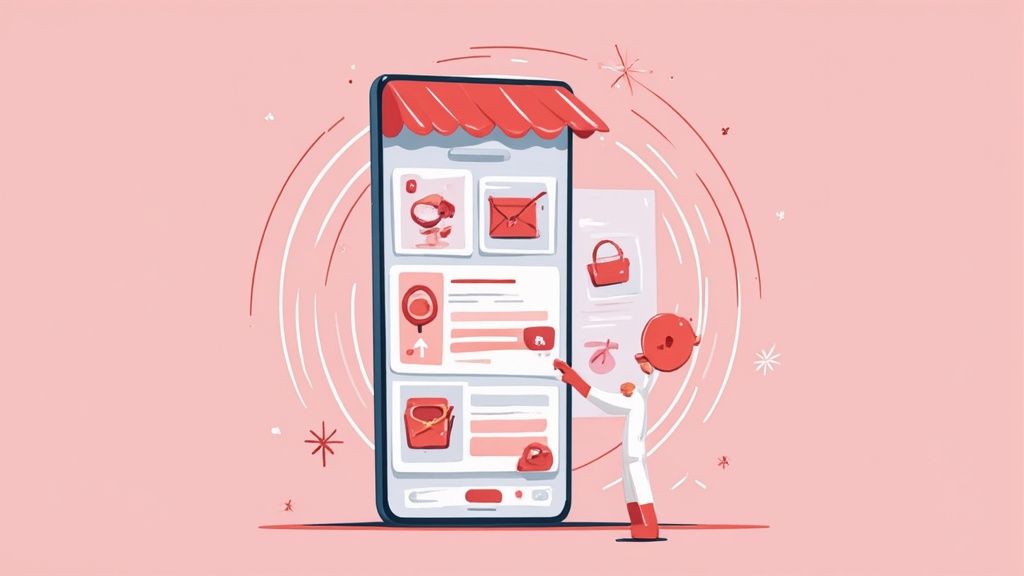
The device in your pocket gets smarter every year, and the world of mobile commerce is evolving right alongside it. The future isn't just about having a mobile-friendly store anymore. We're talking about creating incredibly immersive, intuitive shopping experiences that feel like science fiction brought to life. These technologies are set to completely change what mobile commerce is capable of.
One of the most exciting frontiers is Augmented Reality (AR). Imagine this: you point your phone at your living room and see exactly how that new sofa would look, perfectly scaled to your space. No more guesswork. Retailers are already using AR to let customers virtually "try on" sneakers or test out makeup shades, which is a game-changer for reducing returns.
This push toward more natural interactions is also fueling the rise of voice commerce. Soon, shopping could be as simple as talking to Alexa or Siri. Instead of tapping through menus, you'll be able to reorder your go-to products or find new ones just by speaking—making the whole process faster and more accessible than ever.
Hyper-Personalization with AI
Underneath all these cool advances is the powerful duo of Artificial Intelligence (AI) and machine learning. These are the brains behind creating truly personal mobile shopping journeys that feel like they were made just for you.
AI algorithms analyze your browsing habits and purchase history to predict what you might want next, serving up recommendations that feel spot-on. This isn't just about showing related items; it's about crafting an experience that keeps customers engaged and builds real loyalty.
The next wave of mobile commerce will be defined by its ability to anticipate customer needs before they are even expressed. Intelligent systems will transform passive browsing into a dynamic, predictive, and deeply personal interaction between the brand and the consumer.
On top of that, AI-powered chatbots are getting incredibly good at handling customer service issues instantly, 24/7. These smart assistants can manage everything from order tracking to product questions, freeing up human agents and providing immediate support.
To deliver these kinds of rich, app-like experiences, many businesses are looking at new web technologies. It's worth digging in and comparing a progressive web app vs native app to figure out which approach makes the most sense for your store.
Got Questions About M-Commerce? We’ve Got Answers.
As you start wrapping your head around mobile commerce, a few common questions usually surface. This last section is all about tackling those lingering thoughts directly. We'll clear up the real-world differences between m-commerce and e-commerce and help you figure out if a mobile app is the right play for your business.
Think of this as a quick debrief to give you some actionable insights, making sure you walk away with a solid game plan for the fast-moving world of mobile retail.
What Is the Main Difference Between E-Commerce and M-Commerce?
The easiest way to think about this is that m-commerce is a specialized slice of the e-commerce pie. All m-commerce is e-commerce, but not all e-commerce is m-commerce.
The real distinction comes down to the device. E-commerce is the big umbrella, covering any transaction that happens online, whether it’s on a desktop, laptop, or anything else. M-commerce, on the other hand, zones in exclusively on transactions made through mobile devices like smartphones and tablets. This isn't just a technicality—it forces a totally different approach to design and user experience, one that prioritizes smaller screens, touch navigation, and mobile-native features like push notifications and location services.
Is a Mobile App Necessary for Every Business?
Honestly, no. While a slick mobile app can offer a superior, faster experience and is a powerhouse for building customer loyalty, it's definitely not a one-size-fits-all solution. For a lot of small or newer businesses, the smarter first move is to build a highly optimized, responsive mobile website.
A dedicated app becomes a no-brainer when your strategy revolves around building a community, driving frequent repeat purchases, or using phone-specific features like the camera for AR try-ons. But if your customers only buy every now and then, a killer mobile site will often serve you perfectly well.
How Can I Improve My Mobile Checkout Process?
Fixing your mobile checkout is probably one of the highest-impact things you can do for your store. Your entire goal here is to remove friction—every last bit of it.
- Offer Guest Checkout: Forcing someone to create an account before they can give you money is a classic conversion killer. Don't do it.
- Integrate Digital Wallets: Make paying a breeze. Add one-tap options like Apple Pay, Google Pay, and PayPal.
- Keep Forms Minimal: Only ask for what you absolutely need to process the order. Every extra field is another reason for someone to bounce. Use auto-fill wherever you can.
Streamlining these steps can dramatically cut down your cart abandonment rate and give your mobile conversion numbers a serious boost.
Ready to build a mobile commerce experience that actually converts? ECORN specializes in creating high-performance Shopify stores designed for mobile-first shoppers. From responsive design to deep-dive conversion rate optimization, our experts can help your brand win. Explore our Shopify development services today!







